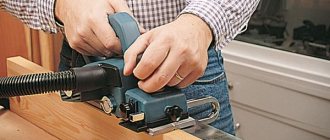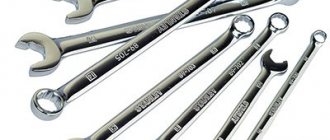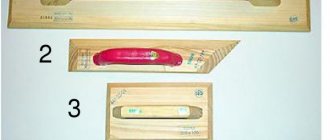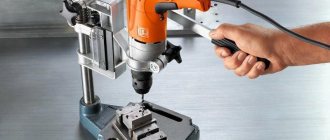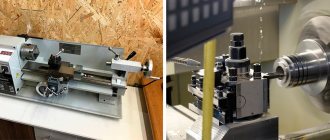A well-equipped locksmith workplace by default implies the presence of a workbench. There are many different models and among them you need to choose the most suitable option for your specific conditions. So, how do the models on the market differ and what are their advantages?
An equipped workplace is necessary for everyone who is engaged in metal processing at an amateur level or professionally. Regardless of the frequency of use, the equipment must be functional, reliable and durable. A metalworking workbench best suits the stated requirements. It is indispensable in all cases where metal processing is planned.
A metal workbench is a specialized table designed for performing metal work. An experienced specialist, of course, has a clear idea of what a locksmith’s workbench should ideally be like. Next, we will consider the equipment options produced today, their features and advantages. Let's figure out which of the existing models is more suitable for professional use and which one is more suitable for amateur use.
Workbench requirements
A master professionally engaged in metalworking does his work only in a specially equipped place. Comfortable conditions and safety will be ensured only if there is a workbench. And, according to practicing experts, it must meet a number of requirements:
- large margin of safety and reliability. It is important that you can work in intensive mode or with large, heavy workpieces;
- maximum functionality and thoughtful ergonomics. A well-organized workplace, where everything necessary for work is always at hand, is a prerequisite for production efficiency;
- sustainability. When you have to work with heavy components, this requirement is mandatory for safety. Without a stable table it is impossible to ensure high accuracy of work;
- immunity to aggressive compounds and other influences. A bench made from high-quality materials lasts for several decades.
Workbench: this is the main element of the woodworker's workshop
In any workshop where they work with wood, there is always a carpentry workbench. Regardless of how the material is processed (manually or using a power tool), the presence of this element allows not only to properly organize the workspace, but also to make it more convenient and comfortable. All this ultimately affects the result. In such conditions, the productivity of the master and the quality of his work increase.
Any carpenter cannot do his work without a workbench.
A workbench is a work table that is used for processing wooden products manually or mechanically. Its design and ergonomic capabilities are designed in such a way that it is convenient for the master to fix parts in different positions to perform various tasks.
The workbench allows you to perform the following operations:
- assembly of wooden structures;
- production of wood parts;
- processing of workpieces with varnishing compounds and other means.
A carpenter's workbench is a table on which a craftsman processes wood products.
On a note! A traditional carpenter's workbench is designed for working with lumber whose length does not exceed 3-3.5 m. To work with longer workpieces, you will have to use a carpenter's workbench.
Design and purpose of a metalworking workbench
In order for a workbench to be truly reliable, durable and practical, its design needs to be worked out in detail. The supporting frame is made of steel. The tabletop is cut out of dense MDF 30 millimeters thick and covered with galvanized iron on top. Such a surface perfectly tolerates any load - dynamic and static. Hammer blows, welding splashes - all this will not affect such a tabletop in any way.
Spilled oil, solvent, gasoline and other mildly aggressive compounds do not react with countertop materials. In addition, the materials do not require any special care - only cleaning the workplace upon completion of a certain stage of work. To enhance the protective properties of the surface, it is recommended to apply powder paint.
It is desirable that the tabletop have edges around the perimeter. Then it will be easier to work with small parts that will not fly off the table. It’s good if the package includes a perforated screen. In this case, there will be a place for attaching the necessary tools - a hammer, a hacksaw, a screwdriver, pliers and various devices. Even more convenience in terms of storing available materials and tools is provided by drawers, cabinets, and shelves.
Depending on the specifics of the work, the lower part of the workbench may differ radically from the upper. The configuration can be highly specialized and intended to perform specific tasks. The shelf and drawers are made with a load capacity of up to 35 kilograms. Sections intended for storing official documentation are equipped with built-in locks and can be locked with a key.
The functionality of a workbench is directly related to its configuration. In production and large workshops, it is very important to have a large assortment of various types of devices and accessories in order to perform a wide range of metal processing operations. In most cases, a home craftsman gets by with a minimal set of tools and equipment. The main list of works that will require a workbench:
- marking metal blanks;
- bending and cutting;
- drilling;
- restoration or cutting of new threads;
- riveting;
- engraving;
- wiping, grinding and polishing the surface.
If we talk about metalworking equipment, the most popular is a vice. They can be made stationary - securely screwed to the surface or removable. In the latter case, the mechanism must ensure quick and reliable fixation of the bench vice to the table top.
Materials for making the frame and cover of a carpentry table
In the process of processing wooden workpieces, the working surface is subjected to serious loads, so increased demands are placed on it. Regardless of whether a regular or folding carpentry workbench is made with your own hands, its structure must be strong and rigid.
A high-quality frame must withstand all types of loads:
The workbench must be made of rigid and durable materials
- Static. They occur under the influence of heavy weight if a massive workpiece is processed on the table.
- Dynamic. They are a side effect of processes such as drilling, sawing, impacts, etc.
The strength characteristics of the frame depend on factors such as the reliability of the fastening elements (nails, bolts, nuts, screws) and the type of material from which it is made. The underframe is made from softwood, such as pine. Although linden or maple are also suitable for these purposes.
The workbench tabletop is made of wood with a high strength index:
Most often, the workbench top is made of wood.
- beech;
- oak;
- maple;
- ash, etc.
To create a carpentry table cover with your own hands, experts recommend using a glued board. In this case, you will not have to spend a lot of time and effort on adjusting the wood. A complete blank in the form of a laminated board will eliminate the need to cut the material, process its edge part, and then glue and level it. The finished shield will cost a little more, but it's worth it.
Helpful advice! When working with wooden workpieces, you can accidentally damage the cover with a power tool. To prevent this, additional flooring can be made for the workbench top made of plywood or fiberboard. It is cut according to the shape and dimensions of the lid. It is better if the protective flooring is made together with the workbench.
The frame of a carpentry workbench is made of wood, less often of metal
Workbench dimensions
The standard size of a single workbench is considered to be 80 cm wide and 150 cm long. These are the optimal dimensions of the working surface for one specialist. The length of multi-person workbenches can be different and reach 3.5 meters. This solution is used when it is necessary to combine the efforts of two or more specialists who will work together on one task.
Ideally, the height of the table is selected according to the height of the master. If we talk about statistical data, then the average height of an employee is approximately 170-180 cm. For him, the optimal location of the table is considered to be 70-90 cm from the base. The main thing is that the specialist does not have to bend over and slouch during the work process.
In the case of individual selection, the best option is to place the tabletop at the height of the palm of a standing employee. In this case, his arms should be straight down, and the palm itself should be horizontal. As statistics show, the standard workbench height is 75-80 centimeters. These days, there are models of tables with adjustable legs on the market. Retractable supports allow you to choose the optimal height of the workplace. The adjustment range is 5-25 centimeters.
Mobile structures occupy a special place. Wheels with locking mechanisms in a stationary position are attached to the legs of such models. The mechanic's workplace can be organized in the most convenient place. This is a good solution for large production sites where it is desirable to carry out work on site or where it is not possible to move parts to a stationary workshop.
How to make a metal workbench with your own hands
It is better to divide any work into several stages. This way you can avoid unnecessary actions and do everything as clearly and efficiently as possible. Let's look at the step-by-step process of making a metal workbench with drawers for tools with your own hands.
- The first step is drawing up a diagram. It is required, at a minimum, to determine the dimensions and outline of the bench, make a sketch and a rough drawing. This will allow you to decide on the materials that need to be purchased. If the drawing of the metalworking bench is ready, the materials have been purchased, and the place for the future metalworking surface has been cleared and ready for installation, then you can begin. The main thing to keep in mind is that for greater strength, the frame is attached to the floor. We'll talk about how to do this correctly a little later. The main thing is that the place for metalwork work is not suddenly needed in one or two weeks. It is extremely difficult to move such a massive structure.
- If everything is ready to begin work, then you can begin making the frame. There are two possible installation options for the frame: welding and metal bolts. It is preferable, safer and more aesthetically correct to choose bolts. But even in this case, you can’t do without welding. It is recommended to use iron angles to create the frame of the metalwork surface. The sheet thickness must be at least 5 mm. The side size is suitable at 35-40 mm. But keep in mind that the thickness of the future tabletop depends on the depth of the corner. It should fit perfectly into the prepared nest. Any protrusions will add unnecessary work on surface processing, and it will not be possible to securely fasten the cleaver to a curved plane. It is better to choose the height of the workbench at arm's length. This will make it more convenient to work. For an average male height of 178-180 cm, the ideal height would be 120 cm. Metal squares with a sheet thickness of about 3-5 m should be welded onto the lower part of the corners. This is the future base of a metalworking workbench. The squares are attached to the floor with anchor bolts, after which it will be difficult to move the legs. The tabletop nest is welded onto the legs. The corners of the tabletop are positioned in such a way that the future working surface will lie in them, like in the nest of some part. This completes the manufacturing of the frame and begins the next stage.
- To increase rigidity, we make two large metal boxes. The height of the box starts from the foot of the tabletop and ends approximately 20 cm to the floor level. This will make it more convenient if there is a great need to move the workbench to another place or dismantle it. The boxes are made from iron sheets 3 mm thick; the sheets are connected by welding. Corners are welded or bolted under the boxes, to which the boxes are bolted. Supports for the drawers are welded into the boxes themselves. It is more practical to make each of the locksmith boxes from not very thick plywood: a sheet of 5 mm will be enough.
- After the installation of the drawers is completed, it is time to take care of the countertop. It is highly recommended not to use metal for these purposes. The most practical option would be wood impregnated with a fire-resistant composition. A slab made of natural or artificial stone would be better, but it is much more expensive, so the decision is entirely up to the future owner.
- The shield can be a sheet of plastic or iron secured with bolts. Plastic is more practical in terms of fastening, and a steel screen is more reliable. You can attach the shield to the base using the same anchor bolts. It is not difficult to make and secure a workbench screen with your own hands, but this will increase safety, and therefore you should not neglect the shields.
As you can see, making a metal workbench for metalwork is not such an impossible task: it’s more like putting together puzzles. The main thing is to think through each stage and work out an action plan in advance, find out what types of fasteners and materials there are in order to choose the right one.
Types of workbenches and equipment
The metal workbenches produced today can be divided into several groups depending on the type of design, equipment and the amount of space for storing tools:
- Boothless. It is a fairly simple design, consisting of a reinforced table, and sometimes also a shelf. Since there is no place to store tools and other accessories, the master will need wall shelves, cabinets or tool carts. An excellent option for a garage or small home workshop.
- Single pedestal. Equipped with one compartment for storing accessories. It is available on the market in several versions. A place to store equipment can be a bedside table with shelves and a door, a compartment with drawers, or a combined solution. Sometimes there is a large space under the cabinet without shelves or drawers. It can be used for open storage.
- Double pedestal. The model is designed in such a way that it has two storage spaces located under the tabletop. They are made in the form of hinged or retractable compartments.
- Three-pedestal. The most spacious and multifunctional models, where almost all free space is divided into areas for storing equipment. Designed for workplaces where a large number of tools and additional equipment are required to perform current tasks.
There are requirements for drawers:
- it must be removed from the niche to its full length, but not fall out of it;
- the box must be supported on reinforced guides that can easily withstand the load from hand tools or heavy equipment;
- The inside of the drawer should be equipped with organizers for easy storage of small items.
An important element of a professionally equipped workbench is the perforated screen. The holes make it possible to fix equipment or tools with the simplest devices: clamps, hooks and various kinds of holders.
Editor's Choice
BLACK+DECKER WM301-XJ (from 3000 rubles)
BLACK+DECKER WM301-XJ.
Photo: yandex.market.ru The American brand of tools opens a rating of the best workbenches presented in 2022. Although the tool was made in China, buyers still speak warmly about the quality of the product. The series is called Workmate, which translates from English as “partner.” One of the main advantages of this carpentry table is its folding design. This is convenient to store, transport and take out as needed. The body has levers that increase the compression force of the vice. The base is made of steel. The legs have rubber pads to prevent slipping. Available settings for vices and stops so that workpieces of various shapes can be mounted on the work surface. The table top is made of bamboo plywood. This is a significant advantage compared to competitors, who often resort to crumbling chipboard.
Characteristics:
| Type | Universal |
| Maximum load | 160 kg |
| Workbench height | 760 mm |
| Desk Length | 610 mm |
| Desk depth | 341 mm |
| Housing material | Steel |
Bamboo work surface
Labor-intensive to assemble the first time you use it
show more
KETER 17182239 (from 10.7 thousand rubles)
KETER 17182239. Photo: yandex.market.ru
Professional tool for the master. This participant in the ranking of the best workbenches of 2022 is assembled in Israel. The company specializes in plastic products for various purposes. This workbench is made of polypropylene. Although the tool is foldable, when unfolded it turns into a full-fledged workplace without any amendments and reservations that have to be made when we are talking about mobile tools. The surface can withstand workpieces or tools weighing up to 453 kilograms. So you can work not only with large wooden beams, but also with metal. Some may not like that it is not made of wood. But objectively speaking, plastic is much stronger than even bamboo plywood or MDF. Plus, you can safely put it outside and forget it, without fear of weather vagaries.
Characteristics:
Components: legs, tabletop, clamp.
| Type | Versatile, foldable |
| Maximum load | 453 kg |
| Workbench height | 755 mm |
| Desk Length | 850 mm |
| Desk depth | 550 mm |
Huge work area
The quality of the plastic could be better
show more
RYOBI RWB03 (from 7200 rubles)
RYOBI RWB03.
Photo: yandex.market.ru If you are looking for the best steel workbench, then this sample is a clear leader in 2022. Its design is similar to other mobile tools, but the materials are much stronger. All components are made of steel. However, this also affected the weight: if workbenches with wooden tabletops weigh on average 6-8 kilos, then this one reaches 12.5. Although the maximum load here is a standard hundred square meters. Although in the reviews there are mentions that this or that element was bent after use, next to them there is always a remark in the spirit of “stood on it with your foot” or threw a thick steel sheet over it. You need to understand that this is not an industrial tool, but still a compact assistant. The frame elements are securely connected with fasteners. The tabletop is fixed not in three classic positions, but in four - 0, 25, 50 and 80 degrees. The clamping system is sliding. This allows you to work with different types of workpieces. The height is adjustable, which not all workbenches have. This has seven positions, which are quite enough for masters.
Characteristics:
Height adjustment possible.
| Type | Folding, sliding work desk |
| Maximum load | 100 kg |
| Workbench height | 760 mm |
| Desk Length | 600 mm |
| Housing material | Steel |
Wide range of adjustment options
Weight
show more
The final stage of assembling a workbench for carpentry work
When all the elements of the frame have been assembled, you can begin installing the drawers and fittings. First of all, you need to install the guides in the cabinet located on the right. To make work more convenient, it is better to use temporary inserts in the form of wood panels.
At the final stage, the product is polished.
Instead of homemade wooden guides, you can use ready-made factory-made retractable systems. Such fittings (provided they are of high quality) operate silently and trouble-free. These guides can be designed for either full or partial extension. Next, the storage boxes are assembled. For this, screws and adhesive intended for wood are used. The size of the facades is selected taking into account the dimensions of the cabinet.
Note! It is imperative to leave a small gap (about 1-3 mm) between the facades, otherwise the drawers will not slide out well.
As a functional addition, a movable bar can be installed on the spacer, along which one or more guide rollers will move. Their number depends on what work will be carried out in the workshop. So that the roller can move freely up and down, a slot is made in the movable bar for it, and then a wing nut is installed, which will serve as a clamping screw.
A roller is installed in the upper part of the movable bar. To do this, use a U-shaped holder. It must have slots or holes on the sides intended for the roller axis.
Sometimes craftsmen resort to other carpentry tricks, and homemade devices made with their own hands become an excellent addition to a workbench and other equipment:
- compact stands and holders for cutters;
- sliding stops for miter saw;
- magnetic pads on the jaws of clamps (pipe);
- devices for creating precise corner holes with a drill;
- guide bars for circular saw;
- MDF benchtop machines for eccentric sander, etc.
Ready-made carpentry workbench with swivel top and drawers.
Next, you need to install carpentry tools on the workbench with your own hands. When installing electrical equipment on a hinged cover, it is imperative to maintain balance. Do not load only one side or one corner of the workbench. The set screws are buried at least 2/3 of the thickness in the turning part of the tabletop. This allows you to achieve reliable fixation, because electrical carpentry equipment has considerable weight. In the side areas, where the working area remains stationary, this fastener can pass through the entire thickness of the cover.
In its finished form, a homemade workbench with a rotating tabletop and equipment installed on it is very convenient and functional. To protect wood from the negative effects of moisture, it is advisable to coat it with a primer or even paint. All parts are processed before assembling the workbench and must be thoroughly dried. Painting will also improve the appearance of your workshop bench.
Design Features
Despite the fact that workbenches differ from each other not only in their dimensions, but also in their intended purpose, their design is approximately the same. A workbench made with your own hands is visually similar to a regular desk, complemented by various tools and parts. After all, the main purpose of a workbench is to keep everything you need at hand.
- The main structural element is the frame, usually made of metal. It is the support for the entire device.
- An equally important element is the tabletop - a strong, thick table surface that can withstand enormous loads, for example, a powerful blow from a hammer. Can be made of dense wood or metal. The tabletop is designed for installation on its surface of the necessary metalworking tools (clamp, machine, etc.).
- Nightstands. There may be several of them. They are most often located at the edges of the tabletop. Each cabinet may contain several drawers for storing tools (hammer, pliers, screwdrivers), which may be needed at any time during repair work.
- Additional shelves for storing tools are also installed in the workbench. As a rule, shelves are installed under or above the countertop.
A protective screen is hung on the working wall to which the workbench is installed, protecting the surface from various mechanical damage. Moreover, on such a screen you can always equip additional hanging shelves where the necessary devices and tools will be stored.
The workbench should be installed in a well-lit place. Therefore, there should be a socket near the equipment to connect a turning lamp to it. You can place the lighting in any convenient place: above the workbench, on the side or next to the device.



